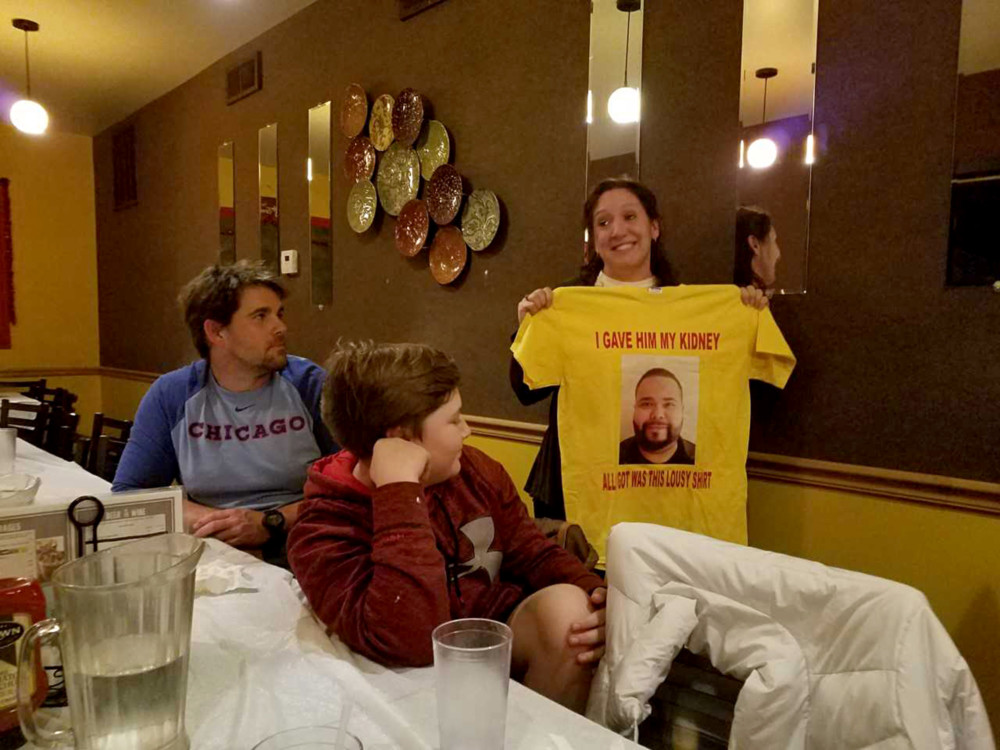By Michelle L. Quinn
Post-Tribune/Chicago Tribune
WWR Article Summary (tl;dr) Meet the two co-workers who are bonded by a deep, abiding friendship as well as a body part.
CHESTERTON, Ind.
Jason Reyes will never forget the last time he ate shrimp, he said.
It was a few weeks ago, following a Dec. 27 kidney transplant, when he ordered some shrimp with cocktail sauce and experienced some significant stomach pain, he said. It was possibly worse pain than the surgery itself, and definitely more depressing, he said.
Doctors warned him he would discover very quickly that his diet was going to change whether he liked it or not. But even if he never gets to eat another morsel of the foods he loves, it’s a trade he’s grateful to make.
Reyes, 35, of Hobart, was given a new lease on life, and from the most unexpected place: Heather Szymaszek, a Chesterton woman who handles scheduling at ArcelorMittal Indiana Harbor plant, where they both work.
Reyes’ health had been precarious since he was diagnosed with Type 2 diabetes 14 years ago, he said.
“I was diagnosed with it when I was 21, and the high blood pressure that comes with it was beating up on my kidneys. I didn’t want to face it, though, and I was in denial for a long time,” Reyes said. “Then eight years ago, things started getting really bad, so I had weight-loss surgery and that slowed (the disease’s progression) for a while.”
The situation turned dire a year ago, however, during a California vacation. He started retaining fluid to the point where he could neither breathe nor walk without incredible difficulty, he said.
The subsequent meeting with his nephrologist upon his return confirmed the worst: Reyes would start dialysis immediately and be put on the donor list for a new kidney. It took all he had to keep it together, he said.
“My biggest fear was telling my family because they would be scared,” he said. “Not very many people knew I was sick, and I didn’t want them to worry. I went through the mix of emotions: scared, and then I got mad about it. But I was always worried about other people, especially my son, that I didn’t have time to think about what it meant for me.”
He had plenty of time to think about things during the four hours and 15 minutes he spent hooked up to the dialysis machine three days a week. Namely, dialysis is a wretched experience.
Shortly after Reyes went on leave from the mill, Szymaszek was in a clerk’s office at work one day when she overheard a call between that person and Reyes. He called to let the company know he wouldn’t be coming back to work for a long while, if ever, because he’d gone into kidney failure.
Although Szymaszek didn’t know him well at the time, she was compelled to reach out, she said.
“I messaged him and said, ‘Well, I’m O-negative, so if you need something, like a kidney, let me know,’ ” she said.
The gesture stunned Reyes. With 100,000 people on the donor list, he was thrilled yet didn’t want to get his hopes up.
“When she messaged me, I never expected her to be like, ‘Here! Have my kidney!’ ” he said. “I never thought I would have the opportunity right away.”
In August, the two were working with the University of Illinois at Chicago Hospital, Reyes said.
Dr. Enrico Benedetti, the hospital’s attending transplant surgeon, said he and his team perform the surgeries using a robot. Doing so is less invasive and leaves patients, especially those with higher body-mass indexes such as Reyes, less prone to infection.
Meanwhile, a battery of tests for Szymaszek made sure she was in good health. At the end of it all, Szymaszek’s kidneys were more than viable for transplanting.
“When we got the date, I was like ‘We’re going to have surgery,’ ” she said. “But he has to go through dialysis, and I thought, ‘I have nothing to be nervous about.’ ”
The mother of twins said their delivery, “was a lot tougher than what (the surgery) sounded like.”
Both surgeries went off without a hitch Dec. 27, Szymaszek’s birthday, and now, nearly two months later Reyes’s health has rebounded. Benedetti said that as long as Reyes is diligent with taking his anti-rejection medication and keeping up with his health, he’ll easily enjoy at least 10 years problem-free with Szymaszek’s kidney.
“Diabetic patients do worse on dialysis; the 5-year survival rate is between 20 percent and 30 percent,” Benedetti said. “That same group of patients who have a live donor have a 90 percent chance of living five years and at least 70 percent for 10 years. But (transplant patients) are the essential agents of their own luck, so they must take the drugs that suppress the immune system so that the organ will be accepted, but not so much that they get sick.”
Perhaps the best part of the experience for both is that now the two are bonded by a deep, abiding friendship as well as a body part. There is one other side effect Reyes might have to get used to, though, according to Szymaszek: Basic Girl Syndrome.
“I told him if he starts craving Starbucks or worries about his butt looking too big in yoga pants, he’ll know it’s me,” she said.














































































































































































































































































































































































